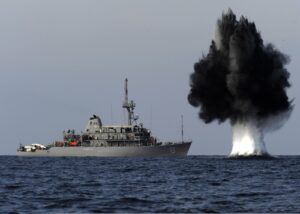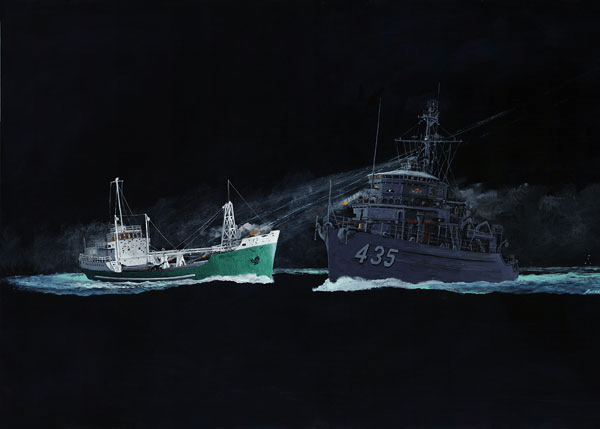
A demolition charge detonates 1,500 meters from the mine countermeasures ship USS Scout (MCM 8) in the Straits of Hormuz on Nov. 19, 2010. The charge was built and detonated by sailors assigned to Explosive Ordnance Disposal Mobile Unit 1 and Mobile Diving and Salvage Unit 2, attached to Combined Task Group 56.1 during joint mine countermeasures training. US Navy photo 101119-N-QW632-023
Commander David Bruhn, USN (Ret) is one of the leading authorities on the history of U.S. Navy mine warfare. He is perhaps best known as the author of the multi-volume Wooden Ships and Iron Men series. Volume I, The U.S. Navy’s Ocean Minesweepers, 1953–1994, tells the story of the long service lives of the 65 U.S. Navy ocean minesweepers (MSO). In addition to duties sweeping mines, they also searched for lost aircraft, ships, and munitions on the sea floor, showed the flag around the world, and participated in nuclear test programs and the NASA space program. Volume II, The U.S. Navy’s Coastal and Motor Minesweepers, 1941–1953, studies World War II, Korea, and the early Cold War. 561 of these coastal and motor minesweepers earned nearly 700 battle stars, 21 Presidential Unit Citations, and 15 Navy Unit Commendations during World War II. Reduced to only 16 vessels by the time of the Korean War, this class of ships nonetheless bravely earned 124 battle stars, 7 Presidential Unit Citations, and 7 Navy Unit Commendations. Volume III of the set, The U.S. Navy’s Coastal and Inshore Minesweepers, and the Minecraft That Served in Vietnam, 1953–1976, looks at the role these boats played during the Vietnam War, including coastal interdiction patrols and ensuring safe passage on inland waterways. During the war, these boats earned four Presidential Unit Citations, three Meritorious Unit Commendations, and three Navy Unit Commendations. Bruhn’s diligent research brings the story of Navy mine warfare to life in this three volume set.
Bruhn served twenty-two years on active duty and two in the Naval Reserve, as both an enlisted man and as an officer, between 1977 and 2001, including two tours aboard Mine Warfare ships. The idea for the first book in the series came to him when he learned during a tour in the Pentagon that USS Excel (MSO-439), which he had served aboard as a junior officer, had been decommissioned and relegated to the “Ghost Fleet” at Suisun Bay, near San Francisco. Research, however, revealed that there was not enough riveting material about Excel to fill a text – but that collectively MSOs had, during nearly four decades of service, participated in many interesting events. Thus was borne the idea of recording their history before it would all be obscured by the passage of time. Volume III is the capstone book in the trilogy devoted to minesweepers, the link between the first two volumes, and companion book to Volume I. After having started working on a book about the smaller brethren of ocean minesweepers, the coastal and inshore minesweepers, he began researching their predecessors from the World War II and Korean War eras, and found an extraordinarily rich and largely ignored subject since Arnold Lott’s book Most Dangerous Sea was published in 1959. Someone once wryly noted that if the submarine force is the “silent service,” then mine warfare is the “unknown service” within the Navy, receiving few resources and little publicity. Bruhn, who commanded two Avenger-class Mine Countermeasures Vessels, hopes the collective contributions of minesweep sailors since World War II, presented in his Wooden Ships and Iron Men trilogy and the Mine Warfare Hall of Valor, will help change this precept.
Bruhn’s work on the history of mine warfare continues in the online arena. He maintains a website which contains an extensive “Mine Warfare Hall of Valor” as well as a “Yard Patrol Vessel Hall of Valor.” These online documents tabulate awards presented to both ships and individuals, as well as the text from individual citations. His goal is to link the citations for medals of valor to create a coherent portrait of the rich history of the U.S. Navy’s Mine Warfare community. He is focusing on Minesweeping helicopter crewmen, Explosive Ordnance Disposal divers, Underwater Demolition Team divers, Minesweep sailors, and Minemen. Bruhn hopes that this online Hall of Valor will help preserve the collective legacy of these past and present members of the Mine Warfare Community, and also provide in a single location useful information for historians and researchers. This online information is a work in progress, and he welcomes corrections and changes where appropriate. Additionally, he is seeking additional information from the Mine Warfare community, including citations that he can provide links to. The ultimate goal is to provide a comprehensive resource for the public to use. Bruhn can be contacted at davidbruhn@davidbruhn.com.



Barb Kantner
Stanley Day - VSO
R. Goodman
R. Goodman
Daniel Boudreau
Larry Miko
Dennis Rhoades
Rudolph Goodman
Cliff Baggett
Jim Brenner
SB Frost